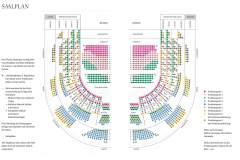The Bat, Ballet
December 2025 | ||||||
|---|---|---|---|---|---|---|
Mo | Tu | We | Th | Fr | Sa | Su |
The bat | Ballet
Act 1approx.: 45 minutes
pause approx.: 25 minutes
Act 2 approx.: 45 minutes
Synopsis
Act 1
Scene 1
Bella, a beautiful young woman of high society, in a stately home, somewhere, in Vienna, Budapest, or somewhere else; it doesn't matter: it just has to be a capital of the old Austria-Hungary. Johann is Bella's husband, but does he love her? That's the only question. And Ulrich, the friend of the house? What does he want from her? And there he is! He always appears at the right moment and has gifts for everyone. But why does he give Bella a pair of scissors?
Scene 2
When the light goes out in Bella and Johann's bedroom, the astonished young woman discovers the truth: at night her husband turns into a bat and flies away.
Scene 3
Ulrich rushes over. He assures Bella that in his large suitcase, which he just happens to have with him, he has the only means to control the situation. And he gives Bella the following advice: If she wants to keep a fun-loving man, she must always be the same, yet different.
Her husband must not have the advantage and be able to transform himself. What follows is a lesson in charm, in deceit, in the art of laughter.
Scene 4
In a nightclub, where many women's voices buzz around, Johann has taken off his wings. He is experiencing, as the saying goes, "a beautiful moment." But Bella—thanks to her master's lesson in seduction—is observing him unnoticed. Will he recognize her? She disappears, reappears, disappears; each time she is different, each time unrecognizable. Ulrich's teachings take effect; Johann, surprised in turn, puts on his bat wings again and sets out to pursue the unknown woman.
Act 2
Scene 5
Bella appears at the masked ball in a striking costume. Her husband, who hasn't yet recognized her, follows her everywhere. He becomes increasingly intrusive and tries to seduce her. Ulrich mingles with the guests. He watches as his wonderful plan comes to fruition. Bella appears in costume, the leading lady of the intermezzo. Johann, in the garb of the bat, succumbs to the irresistible attraction of this "unknown." He wants to embrace her and draw her to him. The costumed woman resists, and some guests intervene. A physical altercation ensues. The appearance of a police commissioner and his guards puts an end to the scandal. The waltz music continues, but without Johann, who has been thrown into prison.
Scene 6
Johann in a cage! Locked up and in quarantine. No more waltzes! Love is now enjoyed by others. No more serenades for him; other voices, not his, sing of love beneath the women's balcony. But suddenly the "unknown woman" appears, harassing him. She begs the inspector to release the strange prisoner. Finally, the two are alone, and everything is over: the two spouses behave like lovers, while Ulrich, who brought about this situation, continues to watch them. At the same moment that the recaptured husband succumbs to his wife's charms, Ulrich hands Bella her bag containing the precious scissors. Without hesitation, she cuts off the bat's wings, just as Delilah once cut Samson's hair.
Scene 7
After moments of fear, doubt, champagne, and exuberance, Bella is once again the well-to-do lady of the first scene. Now that the world is right again, what's left to do? We're in the land of the waltz. So dance, ladies and gentlemen, and let the music overwhelm you.
Program and cast
Musical direction: Luciano Di Martino
Choreography & Staging: Roland Petit
Music: Johann Strauss
orchestrated & arranged by: Douglas Gamley
stage: Jean-Michel Wilmotte
Costumes: Luisa Spinatelli
Light: Jean-Michel Désiré
Rehearsal: Luigi Bonino, Gillian Whittingham
Vienna State Opera
Public Transport
Subway lines: U1, U2, U4
Trams: 1, 2, D, J, 62, 65
Buses: 59A
Local Railway: Badner Bahn
Stops: Karlsplatz / Opera
Taxi stands are available nearby.
Parking
Parking is only € 6, - for eight hours!
The Wiener Staatsoper and the ÖPARK Kärntner Ring Garage on Mahlerstraße 8, under the “Ringstraßengalerien”, offer the patrons of the Vienna State Opera a new, reduced parking fee. You can park in the Kärntner Ring Garage for up to 8 hours and pay only a flat fee of € 6, -. Just validate your ticket at one of the discount machines inside the Wiener Staatsoper. The normal rate will be charged for parking time greater than 8 hours. The validation machines can be found at the following coat checks: Operngasse, Herbert von Karajan-Platz, and the right and left and balcony galleries.
Important: In order to get the discount, please draw a ticket and do not use your credit card when entering the garage!
After devaluing your ticket in the Wiener Staatsoper you can pay comfortably by credit card or cash at the vending machines.
The machines accept coins and bills up to 50.- Euro. Parking time longer than 8 hours will be charged at the normal rate.
History
The structure of the opera house was planned by the Viennese architect August Sicard von Sicardsburg, while the inside was designed by interior decorator Eduard van der Nüll. It was also impacted by other major artists such as Moritz von Schwind, who painted the frescoes in the foyer, and the famous "Zauberflöten" (“Magic Flute”) series of frescoes on the veranda. Neither of the architects survived to see the opening of ‘their’ opera house: the sensitive van der Nüll committed suicide, and his friend Sicardsburg died of a stroke soon afterwards.
On May 25, 1869, the opera house solemnly opened with Mozart's Don Giovanni in the presence of Emperor Franz Joseph and Empress Elisabeth.
The popularity of the building grew under the artistic influence of the first directors: Franz von Dingelstedt, Johann Herbeck, Franz Jauner, and Wilhelm Jahn. The Vienna opera experienced its first high point under the direction of Gustav Mahler. He completely transformed the outdated performance system, increased the precision and timing of the performances, and also utilized the experience of other noteworthy artists, such as Alfred Roller, for the formation of new stage aesthetics.
The years 1938 to 1945 were a dark chapter in the history of the opera house. Under the Nazis, many members of the house were driven out, pursued, and killed, and many works were not allowed to be played.
On March 12, 1945, the opera house was devastated during a bombing, but on May 1, 1945, the “State Opera in the Volksoper” opened with a performance of Mozart's THE MARRIAGE OF FIGARO. On October 6, 1945, the hastily restored “Theaters an der Wien” reopened with Beethoven's FIDELIO. For the next ten years the Vienna State Opera operated in two venues while the true headquarters was being rebuilt at a great expense.
The Secretary of State for Public Works, Julius Raab, announced on May 24, 1945, that reconstruction of the Vienna State Opera would begin immediately. Only the main facade, the grand staircase, and the Schwind Foyer had been spared from the bombs. On November 5, 1955, the Vienna State Opera reopened with a new auditorium and modernized technology. Under the direction of Karl Böhm, Beethoven’s FIDELIO was brilliantly performed, and the opening ceremonies were broadcast by Austrian television. The whole world understood that life was beginning again for this country that had just regained its independence.
Today, the Vienna State Opera is considered one of the most important opera houses in the world; in particular, it is the house with the largest repertoire. It has been under the direction of Dominique Meyer since September 1, 2010.

 EN
EN DE
DE IT
IT FR
FR ES
ES RU
RU JP
JP RO
RO
 Seating plan
Seating plan 
